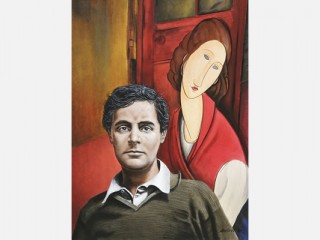
Amedeo Modigliani biography
Date of birth : 1884-07-12
Date of death : 1920-06-25
Birthplace : Leghorn, Italy
Nationality : Italian
Category : Arts and Entertainment
Last modified : 2010-11-26
Credited as : Artist painter, and sculptor,
Amedeo Modigliani, an Italian painter and sculptor, was one of the most fascinating personalities of the School of Paris in its heroic years and a mannerist with a personal touch.
Amedeo Modigliani was born on July 12, 1884, in Leghorn to a distinguished, well-to-do Italian-Jewish family. He first studied under Guglielmo Micheli, a minor painter in the Macchiaioli group, and then at the academies of Florence and Venice, where he was greatly influenced by the art of the Renaissance. All his work echoes the painting of the Sienese 14th century, Sandro Botticelli, and the mannerists.
In 1907 Modigliani arrived in Paris, where, in the Montmartre district, he lived a truly bohemian life. He met the avant-garde young artists at the Bateau-Lavoir, an old building where many of them had their studios, and took part in their discussions. His closest friends were Chaim Soutine and Jules Pascin, and at one time he worked with the painter Moise Kisling. Aristocratic, good-looking, and melancholy, Modigliani undermined his health through alcoholism, drugs, and an uninhibited amorous way of living.
Modigliani exhibited at the Salon des Independants of 1908. His first sculptures were produced in 1909. That year he went back to Leghorn, returning to Paris in 1910, where he lived for the rest of his life. He moved restlessly from one apartment to another and finally transferred from Montmartre to Montparnasse in 1913, where he continued his bohemian life. He could be found regularly at the Cafedela Rotonde or at the Dôme. Although he came from a rich bourgeois background, he had a genuine feeling for social responsibility. In Paris he was known as Modi, from which abbreviation, by linguistic corruption, the French referred to him (and also to Pascin, Soutine, and Maurice Utrillo) as peintre maudit (cursed painter).
The classically balanced character of Paul Cezanne's mature work impressed itself early (1909) and decisively on Modigliani's sensitive mind. His distinctive style resulted from a combination of his predilection for a musical outline, a thoroughgoing simplification of form, and the impact of African sculpture (to which he was introduced by his friend Constantin Brancusi) with Cezanne's manner of applying thin, translucent paint to canvas. Modigliani's sculptures of 1909-1915 also owe something to African tribal styles.
Modigliani was predominantly a painter of nudes and portraits, first working under the influence of Henri de Toulouse-Lautrec, whom he admired and in whose favorite places he was frequently seen at night. The infinite variety of the human face, its expression as type and individual, the sinuous contours of the female nudes, their ingenious placement within the framework of the picture, the new and unexpected angles from which they were visualized—all these were Modigliani's favorite themes. He was extraordinarily gifted in inventing novel aspects of his subject matter, a great master of variety.
Modigliani's masterpieces were created between 1915 and 1919. It seems that he had matured all at once. In 1918 he took part in a group show at the Berthe Weill Gallery; his nudes provoked a scandal and the police closed the show. The dealer Leopold Zborowski made great sacrifices to enable Modigliani to paint, and at one time the English poet Beatrice Hastings supported him generously. Although helped to some extent by his family, Modigliani was often near starvation, owing to the excesses of his style of living.
Modigliani's health was delicate, and he had to spend the winter of 1918/1919 in Cannes. He returned to Paris in the spring of 1919 for the birth of a daughter borne by his young mistress and model Jeanne Hebuterne. The following winter he contracted tuberculosis and was taken to a hospital, where he died in a charity ward on Jan. 25, 1920.
Modigliani is considered by many to be the greatest Italian artist of the 20th century. Among his masterpieces of painting are the Yellow Sweater (ca. 1919) and Reclining Nude (Le Grand nu; ca. 1919). His portraits are of uniformly high quality, for example, the one of Zborowski. (1916) and the series of Beatrice Hastings and Jeanne Hebuterne. His work, although involved in the advanced developments of Paris, nevertheless remained a direct continuation and fulfillment of the classical Italian tradition. As painter, sculptor, and draftsman, Modigliani had a leading place in the modern movement and was among the few truly great masters of the School of Paris.
James Thrall Soby, Modigliani: Paintings, Drawings, Sculpture (1951), gives a general picture of the life and art of the artist. A useful introduction to Modigliani, with good color reproductions and detailed descriptions of the plates, is Alfred Werner, Amadeo Modigliani (1966). Werner's Modigliani, the Sculptor (1962) is an important specialized study. A penetrating biography in depth is Pierre Sichel, Modigliani: A Biography of Amadeo Modigliani (1967). For general background see James Thrall Soby, Twentieth Century Italian Art (1949).
Mann, Carol, Modigliani, New York: Thames and Hudson, 1991.
















